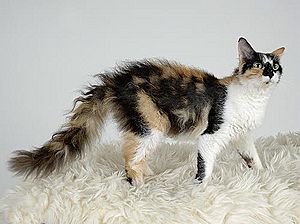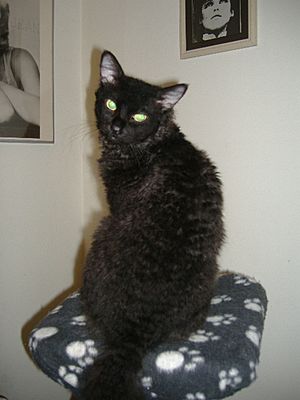LaPerm facts for kids
Quick facts for kids LaPerm |
|
|---|---|

Calico LaPerm cat
|
|
| Origin | United States |
| Breed standards | |
| CFA | standard |
| FIFe | standard |
| TICA | standard |
| GCCF | standard |
| Other | WNCA SACC |
| Domestic cat (Felis catus) | |
The LaPerm is a special cat breed known for its unique curly fur. The name "LaPerm" comes from the word "perm" because of its wavy coat. You'll find the tightest curls on their tummies, throats, and behind their ears. LaPerm cats come in many different colors and patterns. They are also known for being very loving and friendly pets.
Contents
About the LaPerm Cat
The LaPerm is a type of rex cat breed. This means they have a special gene that gives them their curly fur. This breed first appeared in the United States. Now, you can find LaPerms in many countries around the world.
What Makes LaPerms Special?
LaPerms have a unique dominant gene that causes their curly coats. This gene is different from the genes that cause curly fur in other rex cat breeds. They have a graceful and athletic body shape. These cats are usually very affectionate, active, and outgoing. Many people believe LaPerms are hypoallergenic cats. This means they might cause fewer allergic reactions in humans compared to other cats. Their most noticeable feature is their coat. It has soft waves, curls, and ringlets, making them look like they just got a "shaggy perm."
The History of LaPerm Cats
The LaPerm breed started by accident in the early 1980s. It began with cats that were originally kept to help with pest control on a farm.
How the Breed Started
The first LaPerms came from a farm in The Dalles, Oregon, owned by Linda and Richard Koehl. Their cat, Speedy, gave birth to a kitten with curly fur. They named this special kitten Curly. All LaPerm cats today are related to Curly. For about ten years, the Koehls let a group of these curly-coated cats live and breed freely. Later, they connected with cat enthusiasts and started a formal breeding program.
Where the Name Comes From
The breed was named "LaPerm" because their curly coat looks like a shaggy perm hairstyle. The name also follows a tradition from the Chinookan people. They often used French words and added "la" (meaning "the" in French) to create new words. For example, in their language, "pipe" became lapeep and "apple" became lapom.
What LaPerms Look Like
The LaPerm is a balanced cat breed, meaning it doesn't have any extreme features. However, its coat is definitely unusual!
Body and Head
LaPerms are medium-sized cats with a muscular body. They have fairly long legs and a long neck. Their head is shaped like a modified wedge with soft, rounded edges. Their muzzle is a bit wider than the rest of their face. From the side, their straight nose leads up to a flat forehead. LaPerms also have broad noses, ears that flare out, and medium-large, almond-shaped eyes.
Coat Colors and Patterns
Like other rex breeds, LaPerms can come in all sorts of colors and patterns. Tabby, red, and tortie (calico) patterns are quite common because of the breed's origins. Some unique colors like lilac, chocolate, and colorpoint (where the ears, face, paws, and tail are darker) are also popular. Newer patterns like ticked tabbies and shaded coats are also being bred.
The Unique LaPerm Coat
The LaPerm's coat feels textured, not silky. It has a slight "drag" when you run your hand over it, similar to mohair. It's usually soft, though short-haired LaPerms might have a bit more texture. The coat is loose and springy, standing away from the body. It doesn't have a thick undercoat, making it feel light and airy. Judges sometimes blow on the coat to see how easily it parts.
The coat changes with the seasons and as the cat grows. The longest and most defined curls are usually around the neck and on the ruff (the fur around the neck). They also have long, curly fur inside their ears, tufts of fur at the ear tips, and "ear muffs" (longer, silky hair on the backs of the ears). Long-haired LaPerms have a curly, plumed tail, while short-haired ones have tails that look like bottle brushes. Both types have long, curled whiskers. Sometimes, the fur even naturally parts along their back.
Spreading the Breed Around the World
After starting in the United States, LaPerms began to spread to many other countries.
In the United States
The first LaPerms were on Linda and Dick Koehl's farm in Oregon. Other breeders joined them to help develop the breed. The LaPerm Society of America (LPSA) was formed in 1997. This group helped the breed gain recognition with the CFA. In 2003, TICA officially recognized the LaPerm for championship status. The breed also gained championship recognition in CFA in May 2008.
In the United Kingdom
The first LaPerm arrived in the UK in May 2002. She was a long-haired cat named Champion Uluru BC Omaste Po of Quincunx, imported from the United States. She was pregnant and gave birth to five kittens shortly after arriving. These kittens became the starting point for the UK breeding program. The LaPerm Cat Club was formed in 2004. In June 2012, the LaPerm gained full championship recognition with the GCCF.
In Other Countries
LaPerm breeding programs have grown in many other places. They were brought to Canada, New Zealand, Australia, and South Africa. LaPerms also arrived in Japan in 1997. In Europe, the first LaPerms were imported to Germany and the Netherlands. The breed also spread to Sweden and Russia. The first LaPerm in Taiwan was imported from Japan. The breed continues to grow in popularity worldwide. In 2013, FIFe (a major international cat organization) granted provisional recognition to the LaPerm.
Breeding Policies
Different cat organizations have rules about how LaPerms can be bred to keep the breed healthy and true to its type.
Outcrossing for Health
In TICA, breeders often use domestic short-haired and domestic long-haired cats for outcrossing. Outcrossing means breeding a LaPerm with a cat of a different breed or a non-pedigree cat. This helps to keep the gene pool wide and healthy. When breeders use non-pedigree cats, they try to choose ones that look similar to the LaPerm body type and have suitable coats. This practice helps maintain the original look of the breed.
Rules in Different Organizations
In some countries, like the UK, there are strict rules about selling kittens from outcross matings as "pedigree" cats. A cat needs a fully recorded three-generation pedigree to be legally considered a pedigree cat in the UK. This means at least three generations must be bred after an outcross to establish a full pedigree record.
The Cat Fanciers' Association (CFA) allowed the Ocicat to be used for outcrossing for a short period. Now, CFA breeders can only use non-pedigree domestic cats for outcrossing, and after 2020, no outcrosses will be allowed. However, CFA does accept LaPerms from other registries that might have other breeds in their background.
The GCCF has very strict rules. Only LaPerms with a full three-generation pedigree of only LaPerm to LaPerm breeding are fully registered. They also have a list of approved breeds for outcrossing, such as the Somali/Abyssinian, Asian/Tiffanie/Burmese, Ocicat, and Tonkinese. Domestic Shorthairs and Longhairs can be used, but their first offspring are placed on a special register and cannot be shown. These rules help protect the unique genetics of the LaPerm breed.
Images for kids








